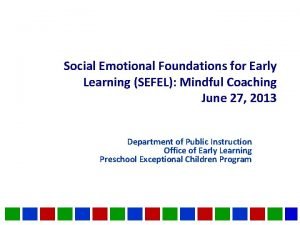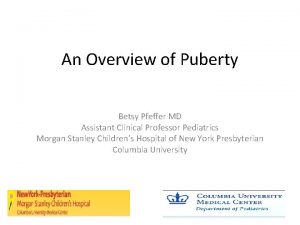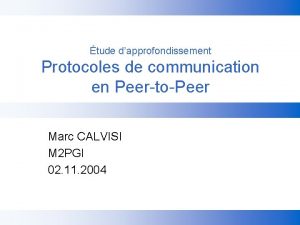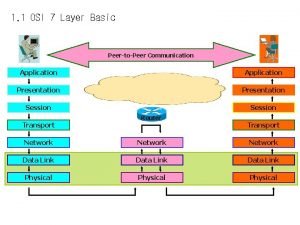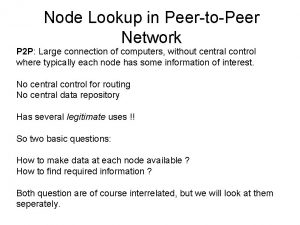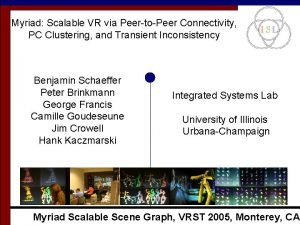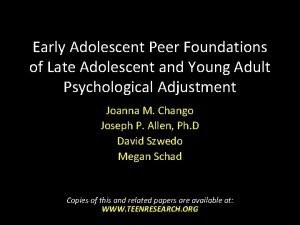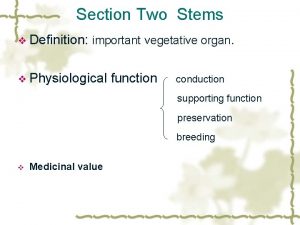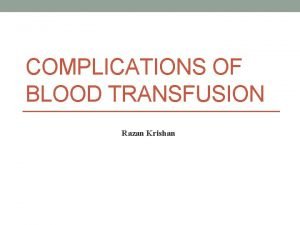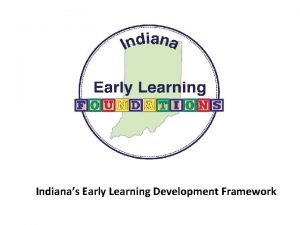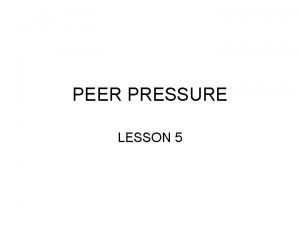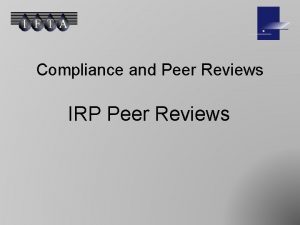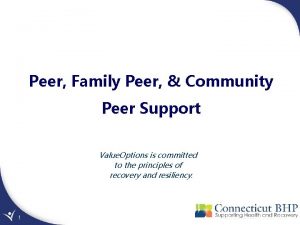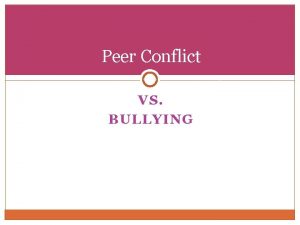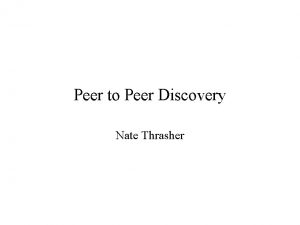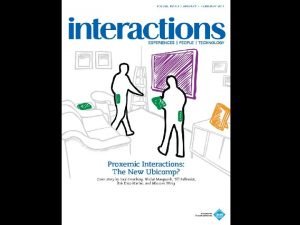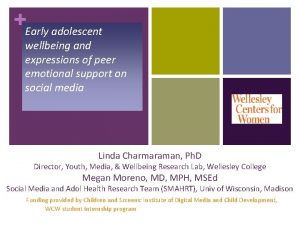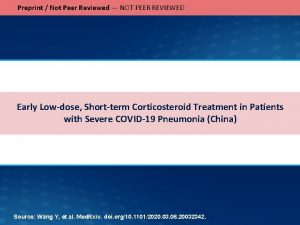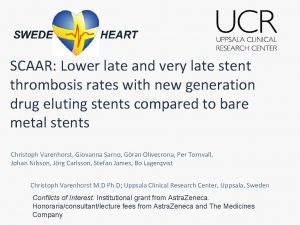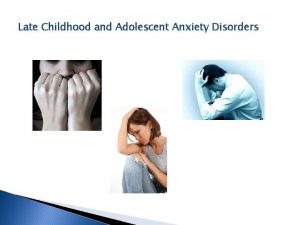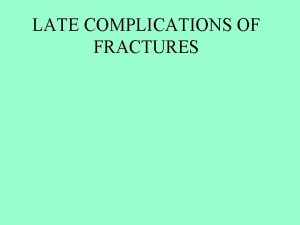Early Adolescent Peer Foundations of Late Adolescent and

































- Slides: 33

Early Adolescent Peer Foundations of Late Adolescent and Young Adult Psychological Adjustment Joanna M. Chango Joseph P. Allen, Ph. D David Szwedo Megan Schad Copies of this and related papers are available at: WWW. TEENRESEARCH. ORG

Self Determination Theory Competence Autonomy Relatedness Positive Self. Motivation and Personality Development

Self Determination Theory Competence Autonomy Relatedness Positive Self. Motivation and Personality Development

Autonomy and Relatedness • Related to range of positive adolescent outcomes: – High self esteem – Ego development – Attachment security – Lack of depressive symptoms – Closer friendships, higher social acceptance – Highly correlated, combination is most important

Peer Relationships in Adolescence

Overarching Question • What are the long-term consequences of failing to establish autonomy and relatedness in early adolescent close friendships?

Depression and Peer Relationships • Depression linked to broad markers of problematic peer relationships: – Peer rejection – Lack of popularity – Lack of interpersonal support • Undermining relatedness with peers linked with increases in depressive symptoms over short term in early adolescence

Social Withdrawal and Peer Relationships • Peer difficulties also related to child and adolescent social withdrawal • Social withdrawal show powerful links to longterm psychological and health outcomes – Loneliness – Cardiovascular disease – Earl mortality

Intervening experiences? • Social support found to mediate the link between stress and depressive affect • Friendship quantity and quality found to mediate the link between peer acceptance and loneliness and depression

Research questions • How does a lack of autonomy and connection predict close friendship abilities in late adolescence? • How does a lack of autonomy and connection predict depression and social withdrawal in young adulthood? • Does close friendship competence mediate the expected long-term predictions to depressive symptoms and social withdrawal?

Sample • 184 Adolescents, and their closest peer • Intensive Interviews and Observations with all parties • Assessed Annually, utilizing Ages 13, 18, and 21 • Equal numbers of Males and Females • Socio-economically Diverse (Median Family Income= $40 - $60 K) • Racially Diverse (31% African American; 69% European American) • Very low Attrition

Research questions • How does a lack of autonomy and connection predict close friendship abilities in late adolescence? • How does a lack of autonomy and connection predict depression and social withdrawal in young adulthood? • Does close friendship competence mediate the expected long-term predictions to depressive symptoms and social withdrawal?

Observed Autonomy and Relatedness • 8 -min disagreement task with close peer • Hypothetical dilemma, try to come to a consensus • Coded using Autonomy and Relatedness Coding System for Peer Interactions (Allen et al. , 2001) • Combined scale for behaviors undermining autonomy and connection with close peer: – Avoiding conflict – Overpersonalizing the disagreement – Pressuring – Interruptions/ignoring – Hostility

Close Friendship Competence • Close peers reported on teens’ close friendship competence using the Harter Self-Perception Profile for Adolescents (Harter, 1988) • Two contrasting descriptors, rate the extent to which choice is sort of true or really true about teen • “Some people don’t have a friend that is close enough to share really personal thoughts and feelings with/some people do have a friend that is close enough to share personal thoughts and feelings with. ”

Predicting Relative Increases in Close Friendship Competence Age 18 Age 13 Close Friendship Competence β =. 05 Close Friendship Competence β = -. 20*** Gender Income Lack of Autonomy and Relatedness with Peers Inability to establish autonomy and connection with friends predicts decreases in close friendship competence at age 21

Research questions • How does a lack of autonomy and connection predict close friendship abilities in late adolescence? • How does a lack of autonomy and connection predict depression and social withdrawal in young adulthood? • Does close friendship competence mediate the expected long-term predictions to depressive symptoms and social withdrawal?

Depressive Symptoms • Teens self reported on their depressive symptoms using: – the Childhood Depression Inventory at age 13 (Kovacs & Beck, 1977) – The Beck Depression Inventory at age 21 (Beck & Steer, 1987)

Social Withdrawal • Age 13: Closest peer rated teens’ social withdrawal using the Pupil Evaluation Inventory (Pekarik et al. , 1976) – “S/he often doesn’t want to hang out or do things with other kids” • Age 21: social withdrawal assessed using closest friend ratings on the Adult Behavior Checklist (Achenbach & Rescorla, 2003). – “S/he would rather be alone than with others”

Correlation between depressive symptoms and social withdrawal at age 21 Depressive Symptoms β =. 05 Social Withdrawal

Predicting Relative Increases in Depressive Symptoms Age 13 Depressive Symptoms Age 21 β =. 18* β =. 08 Social Withdrawal Gender Income Autonomy and Relatedness Depressive Symptoms

Predicting Relative Increases in Depressive Symptoms Age 13 Depressive Symptoms Age 21 β =. 18* Depressive Symptoms β =. 08 Social Withdrawal Gender Income Lack of Autonomy and with Relatedness Peers β =. 34*** Inability to establish autonomy and connection with friends predicts increases in depressive symptoms at age 21

Predicting Relative Increases in Social Withdrawal Age 13 Social Withdrawal Age 21 β =. 08 β =. 04 Depressive Symptoms Gender Income Autonomy and Relatedness Social Withdrawal

Predicting Relative Increases in Social Withdrawal Age 13 Social Withdrawal Age 21 β =. 08 Social Withdrawal β =. 04 Depressive Symptoms Gender Income Lack of Autonomy and with Relatedness Peers β =. 18* Inability to establish autonomy and connection with friends predicts increases in social withdrawal at age 21

Summary so far • Lack of autonomy and connection with close peers in early adolescence predicts: – Increased difficulties in close friendships in late adolescence – Increased depressive symptoms in young adulthood – Increased socially withdrawn behaviors in young adulthood

Research questions • How does a lack of autonomy and connection relate to close friendship abilities in late adolescence? • How does a lack of autonomy and connection relate to depression and social withdrawal in young adulthood? • Does close friendship competence mediate the expected long-term predictions to depressive symptoms and social withdrawal?

Age 13 Age 18 Close Friendship Competence Lack of Autonomy & Relatedness Age 21 0. 38*** Close Friendship Competence 0. 19* -0. 18* 0. 34*** Depressive Symptoms Gender Income 0. 15* Depressive Symptoms

Age 13 Age 18 Close Friendship Competence Age 21 0. 38*** Close Friendship Competence -0. 23** -0. 24** Lack of Autonomy & Relatedness 0. 19* -0. 18* 0. 30*** Depressive Symptoms Gender Income 0. 15* Depressive Symptoms Indirect effect =. 06* Total R 2=. 22*** RMSEA= 0. 00 CFI= 1. 00

Age 13 Age 18 Close Friendship Competence -0. 23*** Age 21 0. 42*** Close Friendship Competence -0. 40*** Lack of Autonomy & Relatedness 0. 18* Social Withdrawal Gender Income Social Withdrawal

Age 13 Age 18 Close Friendship Competence -0. 24** -0. 23*** Age 21 0. 42*** -0. 27** Close Friendship Competence -0. 40*** Lack of Autonomy & Relatedness 0. 14 Social Withdrawal Gender Income Social Withdrawal Indirect effect =. 06 Total R 2=. 12* RMSEA= 0. 00 CFI= 1. 00

Limitations • Data are non-causal • Community-based sample, not at-risk for high levels of psychopathology • More research into adulthood is needed

Conclusions • Critical developmental processes show implications for functioning 8 years later • Some continuity in early to late adolescent friendship abilities • Support a stress generation hypothesis of depression (Hammen, 1991)

Conclusions • Partial mediation for depression, less so for social withdrawal • If causal links are supported, may be able to inform psychosocial interventions

Acknowledgements • Thanks to my co-authors Joe Allen, Ph. D, Dave Szwedo, and Megan Schad • Thanks to all of my lab collaborators: Kathleen Mc. Elhaney, Ph. D Caroline White Nell Manning, Ph. D Emily Marston, Ph. D Erin Miga, Ph. D Ann Spilker Amanda Hare, Ph. D Elie Hessel Emily Loeb Barbara Oudekerk Chris Hafen • I would also like to thank the National Institute of Child Health & Human Development for funding awarded to Joseph P. Allen, PI (Grant # 9 R 01 HD 058305 -A 11) to conduct and writeup this project. Copies of this and related papers are available at: WWW. TEENRESEARCH. ORG
 Features of peer to peer network and client server network
Features of peer to peer network and client server network Skype reviews pros and cons
Skype reviews pros and cons Foundations and encounters early american literature
Foundations and encounters early american literature Social and emotional foundations for early learning
Social and emotional foundations for early learning Tanner scale
Tanner scale Annotazioni sulla verifica effettuata peer to peer
Annotazioni sulla verifica effettuata peer to peer Peer-to-peer
Peer-to-peer Peer to peer transactional replication
Peer to peer transactional replication Peer to peer transactional replication
Peer to peer transactional replication Gambar topologi peer to peer
Gambar topologi peer to peer Esempio registro peer to peer compilato
Esempio registro peer to peer compilato Esempi di peer to peer compilati scuola primaria
Esempi di peer to peer compilati scuola primaria Registro peer to peer compilato
Registro peer to peer compilato Peer to peer l
Peer to peer l Peer to peer merupakan jenis jaringan… *
Peer to peer merupakan jenis jaringan… * Bitcoin: a peer-to-peer electronic cash system
Bitcoin: a peer-to-peer electronic cash system Programmazione e sviluppo condiviso compilato
Programmazione e sviluppo condiviso compilato Peer-to-peer communication in osi model
Peer-to-peer communication in osi model Peer to p
Peer to p Node lookup in peer to peer network
Node lookup in peer to peer network Peer-to-peer o que é
Peer-to-peer o que é Peer to peer computing environment
Peer to peer computing environment Peer to peer intervention
Peer to peer intervention Peer-to-peer o que é
Peer-to-peer o que é Peer-to-peer o que é
Peer-to-peer o que é Peer to peer network hardware
Peer to peer network hardware Peer to peer chat application in java
Peer to peer chat application in java Jaringan peer to peer diistilahkan dengan
Jaringan peer to peer diistilahkan dengan Fusiform rays
Fusiform rays Early and late wood difference
Early and late wood difference Early and late complications of blood transfusion
Early and late complications of blood transfusion Complications of blood transfusion
Complications of blood transfusion Tooth development
Tooth development Indiana learning foundations
Indiana learning foundations



